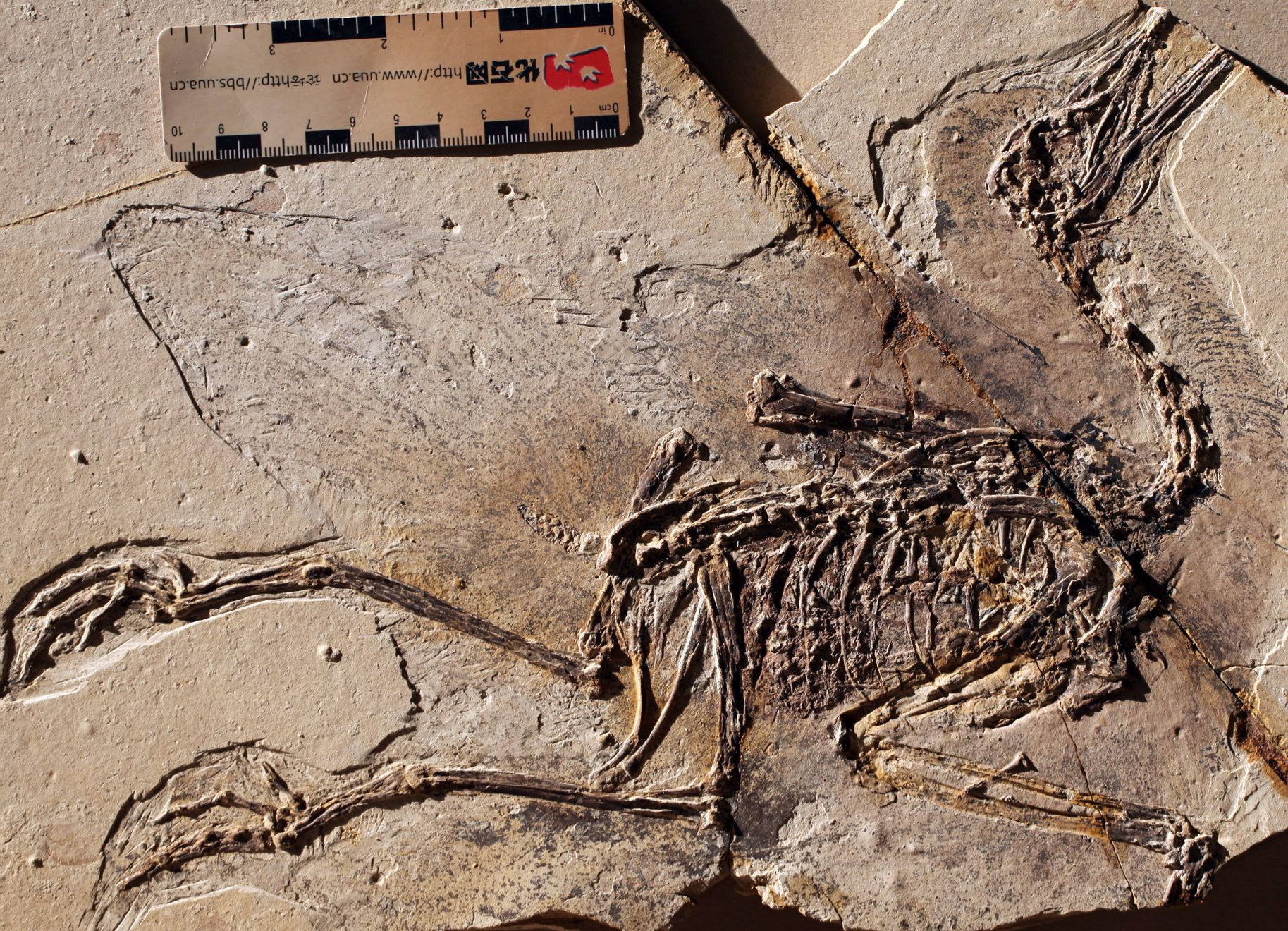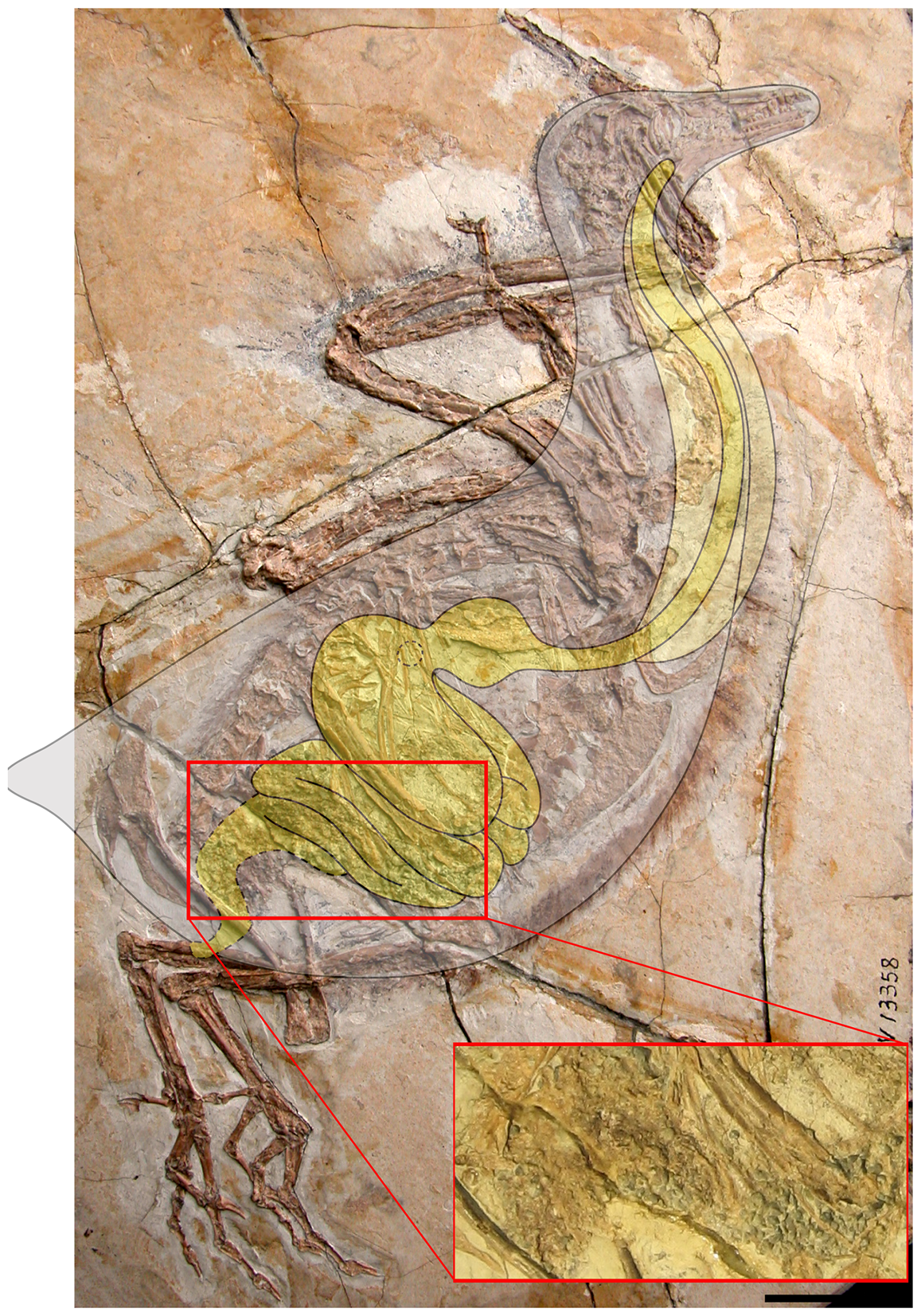Yanornis on:
[Wikipedia]
[Google]
[Amazon]
''Yanornis'' () is an
 ''Y. martini'' was the size of a chicken,Holtz, Thomas R. Jr. (2011) ''Dinosaurs: The Most Complete, Up-to-Date Encyclopedia for Dinosaur Lovers of All Ages,'
''Y. martini'' was the size of a chicken,Holtz, Thomas R. Jr. (2011) ''Dinosaurs: The Most Complete, Up-to-Date Encyclopedia for Dinosaur Lovers of All Ages,'
Winter 2010 Appendix.
/ref> had a long skull with about 10 teeth in the upper jaw and 20 teeth in the lower jaw, and was both able to fly and walk well, having a well-developed U-shaped furcula (wishbone). The absence of the prefrontal bone and the non- diapsid skull allows ''Yanornis'' to be classified as an ornithuromorph, a member of a group of stem-birds which also includes the common ancestor of living birds. Similarly, its
 Several fossil specimens of ''Y. martini'' preserve the remains of fish in the stomach and
Several fossil specimens of ''Y. martini'' preserve the remains of fish in the stomach and
 The
The
extinct
Extinction is the termination of an organism by the death of its Endling, last member. A taxon may become Functional extinction, functionally extinct before the death of its last member if it loses the capacity to Reproduction, reproduce and ...
genus of fish-eating Early Cretaceous
The Early Cretaceous (geochronology, geochronological name) or the Lower Cretaceous (chronostratigraphy, chronostratigraphic name) is the earlier or lower of the two major divisions of the Cretaceous. It is usually considered to stretch from 143.1 ...
bird
Birds are a group of warm-blooded vertebrates constituting the class (biology), class Aves (), characterised by feathers, toothless beaked jaws, the Oviparity, laying of Eggshell, hard-shelled eggs, a high Metabolism, metabolic rate, a fou ...
s. Two species have been described, both from Liaoning province, China
China, officially the People's Republic of China (PRC), is a country in East Asia. With population of China, a population exceeding 1.4 billion, it is the list of countries by population (United Nations), second-most populous country after ...
: ''Yanornis martini'', based on several fossils found in the 120-million-year-old Jiufotang Formation
The Jiufotang Formation () is an Early Cretaceous geological formation in Chaoyang, Liaoning which has yielded fossils of feathered dinosaurs, primitive birds, pterosaurs, and other organisms (see Jehol Biota). It is a member of the Jehol group. T ...
at Chaoyang, and ''Yanornis guozhangi'', from the 124-million-year-old Yixian Formation
The Yixian Formation (; formerly Romanization of Chinese, transcribed as Yihsien Formation or Yixiang Formation) is a geological formation in Jinzhou, Liaoning, People's Republic of China, that spans the Barremian stage of the Early Cretaceous. I ...
.
Description
 ''Y. martini'' was the size of a chicken,Holtz, Thomas R. Jr. (2011) ''Dinosaurs: The Most Complete, Up-to-Date Encyclopedia for Dinosaur Lovers of All Ages,'
''Y. martini'' was the size of a chicken,Holtz, Thomas R. Jr. (2011) ''Dinosaurs: The Most Complete, Up-to-Date Encyclopedia for Dinosaur Lovers of All Ages,'Winter 2010 Appendix.
/ref> had a long skull with about 10 teeth in the upper jaw and 20 teeth in the lower jaw, and was both able to fly and walk well, having a well-developed U-shaped furcula (wishbone). The absence of the prefrontal bone and the non- diapsid skull allows ''Yanornis'' to be classified as an ornithuromorph, a member of a group of stem-birds which also includes the common ancestor of living birds. Similarly, its
scapula
The scapula (: scapulae or scapulas), also known as the shoulder blade, is the bone that connects the humerus (upper arm bone) with the clavicle (collar bone). Like their connected bones, the scapulae are paired, with each scapula on either side ...
and coracoid
A coracoid is a paired bone which is part of the shoulder assembly in all vertebrates except therian mammals (marsupials and placentals). In therian mammals (including humans), a coracoid process is present as part of the scapula, but this is n ...
had evolved the basic shape and layout as in modern birds, enabling ''Yanornis'' to lift its wings far above its back for an efficient upstroke. It was probably a more efficient flyer compared to Enantiornithes
The Enantiornithes, also known as enantiornithines or enantiornitheans in literature, are a group of extinct Avialae, avialans ("birds" in the broad sense), the most abundant and diverse group known from the Mesozoic era. Almost all retained teet ...
(which have the modern condition in a less well-developed form), and especially compared to '' Confuciusornis'' and ''Archaeopteryx
''Archaeopteryx'' (; ), sometimes referred to by its German name, "" ( ''Primeval Bird'') is a genus of bird-like dinosaurs. The name derives from the ancient Greek (''archaîos''), meaning "ancient", and (''ptéryx''), meaning "feather" ...
'', which were only marginally able to perform upstrokes. To allow for the necessarily large flight muscles, the sternum of ''Yanornis'' was longer than it was wide, again representing an essentially modern condition.
Diet
 Several fossil specimens of ''Y. martini'' preserve the remains of fish in the stomach and
Several fossil specimens of ''Y. martini'' preserve the remains of fish in the stomach and crop
A crop is a plant that can be grown and harvested extensively for profit or subsistence. In other words, a crop is a plant or plant product that is grown for a specific purpose such as food, Fiber, fibre, or fuel.
When plants of the same spe ...
, suggesting that these birds were primarily fish-eaters. Their fish-eating and associated adaptations show convergent evolution
Convergent evolution is the independent evolution of similar features in species of different periods or epochs in time. Convergent evolution creates analogous structures that have similar form or function but were not present in the last comm ...
with the unrelated enantiornithine '' Longipteryx''.
One specimen preserved large amounts of supposed gastrolith
A gastrolith, also called a stomach stone or gizzard stone, is a rock held inside a gastrointestinal tract. Gastroliths in some species are retained in the muscular gizzard and used to grind food in animals lacking suitable grinding teeth. In ...
s ("stomach stones") in the gizzard region. Large numbers of small gastroliths are usually associated with species that need to grind tough plant material, such as seeds, after swallowing them. This led some scientists to suggest that ''Yanornis'' was capable of "diet switching", perhaps seasonally, between fish and seeds. However, later studies cast doubt on the diet-switching hypothesis. Further study of the specimen found that the supposed stomach stones were not massed around a single region corresponding with the gizzard, as in other fossils with such stones, including specimens of '' Archaeorhynchus'' and '' Hongshanornis''. Rather, the stones were spread throughout the body cavity in a front-to-back arrangement. This has been suggested to correspond more closely with the intestines, and may represent impacted sand. In modern birds, sand is often swallowed accidentally during feeding (particularly when feeding on dead fish), and, due to some obstruction, may eventually become impacted in the intestines, leading to death.
Classification
In a 2006 study of early bird relationships, it was found that ''Yanornis'', '' Yixianornis'', and '' Songlingornis'' formed amonophyletic
In biological cladistics for the classification of organisms, monophyly is the condition of a taxonomic grouping being a clade – that is, a grouping of organisms which meets these criteria:
# the grouping contains its own most recent co ...
group; since ''Songlingornis'' was the first of these birds to be described, the family containing this group is Songlingornithidae. The order Yanornithiformes has been erected to mark their distinctness from other early Ornithurae such as '' Gansus'', but might be called Songlingornithiformes; especially if the present taxon is indeed a junior synonym
In taxonomy, the scientific classification of living organisms, a synonym is an alternative scientific name for the accepted scientific name of a taxon. The botanical and zoological codes of nomenclature treat the concept of synonymy differently.
...
of ''Songlingornis'' as sometimes proposed.
 The
The cladogram
A cladogram (from Greek language, Greek ''clados'' "branch" and ''gramma'' "character") is a diagram used in cladistics to show relations among organisms. A cladogram is not, however, an Phylogenetic tree, evolutionary tree because it does not s ...
below follows O’Connor ''et al.'', 2013 phylogenetic analysis. The clade names are positioned based on their definitions (contra O’Connor ''et al.'' (2013)).
Name and synonyms
The genus name ''Yanornis'' is derived from the Ancient Chinese Yan dynasties, whose capital was at Chaoyang, andAncient Greek
Ancient Greek (, ; ) includes the forms of the Greek language used in ancient Greece and the classical antiquity, ancient world from around 1500 BC to 300 BC. It is often roughly divided into the following periods: Mycenaean Greek (), Greek ...
''ornis'', "bird". The species ''Y. martini'' was named for avian paleontologist Larry Martin.
''Yanornis'' gained notoriety when the front half of a fossil bird was combined with the tail of a ''Microraptor
''Microraptor'' (Greek language, Greek, μικρός, ''mīkros'': "small"; Latin language, Latin, ''raptor'': "one who seizes") is a genus of small, four-winged dromaeosaurid dinosaurs. Numerous well-preserved fossil specimens have been recovere ...
'' to make the paleontological forgery " Archaeoraptor". Upon discovering this, the bird half was described as ''Archaeovolans repatriatus'', which was later found to be a junior synonym
In taxonomy, the scientific classification of living organisms, a synonym is an alternative scientific name for the accepted scientific name of a taxon. The botanical and zoological codes of nomenclature treat the concept of synonymy differently.
...
of ''Yanornis''.
Some studies have found that the bird species ''Aberratiodontus wui'' is in fact a poorly preserved specimen of ''Yanornis martini'', or at least a close relative, an opinion which has been supported by subsequent reviews of enantiornithine taxonomy.
References
{{Taxonbar, from=Q133517 Euornithes Early Cretaceous dinosaurs of Asia Jiufotang fauna Yixian fauna Fossil taxa described in 2001 Taxa named by Zhou Zhonghe